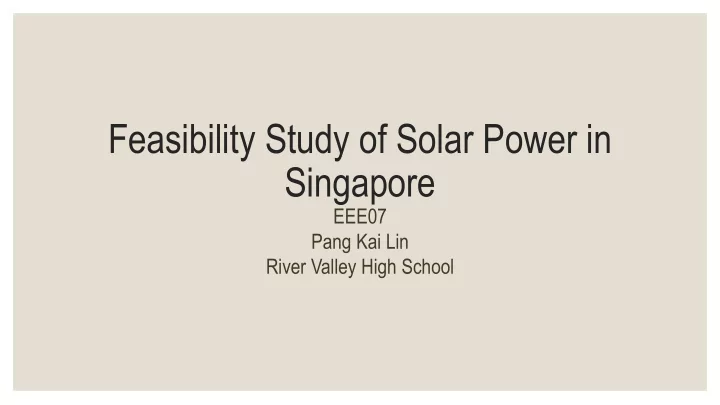

Feasibility Study of Solar Power in Singapore EEE07 Pang Kai Lin River Valley High School
Rationale Decreasing LCOE High and rising electricity No other viable renewable generated via PV energy consumption sources of energy conversion
Rationale • Singapore is ranked 51 out of 220 for electricity consumption • Electricity consumption increased 2.6 times over the past 17 years • A recorded consumption of 48.6TWh in 2017 High and rising electricity consumption
Rationale SINGAPORE • Low wind speeds • Narrow tidal range • Lack of river system • Small land area and high population density Solar irradiance received is 50% more than temperate countries No other viable renewable sources of energy
Rationale • Cost of solar energy declined over past three years • LCOE will decrease from $0.27/kWh to $0.11/kWh in 2020 • Facilitates transformation of energy systems into sustainable solar energy Decreasing LCOE generated via PV energy conversion
Aims Prominence of solar energy Factors affecting as a power source currently performance of a PV cell and in the future
Aims Prominence of solar energy Ambient Projected Annual Output Temperature Solar Irradiance Load Resistance Factors affecting performance of a PV cell
Factors Affecting Performance of PV cell
Matlab Simulation Plotting I-V and P-V curves of the PV array module from Sun Power T5-SPR- 315E Varying solar irradiance starting Varying temperature starting from 0W/m to 1200W/m , 2 2 from 20˚C to 40˚C , solar ambient temperature constant 2 irradiance constant at 1000W/m at 25˚C
Matlab Simulation MPPT Technique: Incremental conductance Cell temperature is affected • Determine exact independently by ambient value of MPP instead temperature and solar of oscillating irradiance • Able to track rapidly changing irradiance
Solar Irradiance • Solar irradiance has significant impact on performance of PV cell • Effect of intermittency, where solar irradiance cannot be ignored • Cloud cover ranges from 24% to 91% in Singapore • Global average trend suggests a small decline in the total cloud cover 0.4% per decade
Ambient Temperature • Ambient temperature does not have significant impact on performance of PV cell • An average rise of 0.25ºC per decade is predicted in Singapore with temperatures varying from 23 ºC to 33 ºC, it would not have significant impact on the energy output of the PV system.
Load Resistance 1. Ensure that solar irradiance is kept constant at around 556W/m 2 Pyranometer 2. Ensure that the ambient temperature is kept constant at 28.0 ℃ using a non- contact thermometer 3. Resistance of the variable resistor was Multimeter varied between 5 Ω and 9 Ω 4. At each value, the voltage and current Variable Resistor output of the PV cell was measured 5. The above steps were repeated three times and average reading was taken
Load Resistance • Optimal resistance of the load to maximize output power is about 6.32Ω , close to internal resistance of PV panel at 7.2Ω • In agreement with Maximum Power Transfer Theorem
Projected Annual Output
Projected Annual Output 1. The experiment was conducted on a clear, sunny day with little cloud cover Pyranometer 2. Readings were taken half-hourly during the peak sun hours, from 9.00am – 6.00pm 3. Solar irradiance, ambient temperature and output voltage and current were measured respectively. The resistance of the load is Multimeter fixed at 7.0 Ω . Variable Resistor 4. Steps 1 and 2 were repeated on two other days and average half hourly readings were taken. 5. Projected annual energy output of the PV cell was calculated.
Projected Annual Output Current against Time Voltage against Time 2.5 14 12 2 10 1.5 8 6 1 4 0.5 2 0 0
Projected Annual Output • Maximum available space for PV installations in Singapore is around 45 km 2 • Dimension of the PV cell used is 1.05m by 0.38m • Total of 1.13 x 10 8 PV cells can be placed • Total projected annual energy output of the entire PV system will be 8.23TWh 17% of Singapore’s total annual energy consumption
Conclusion To optimize performance of PV Projecting into the Prominence of solar energy: system: future: • Solar energy cannot be the • Maximal solar irradiance • Predicted reduction main or sole source of • Negligible impact of ambient in cloud cover in the energy temperature future also suggests • Singapore needs to • Maximum Power Transfer that intermittency consider importing power Theorem might become less of from the utility grid in order a problem to continuously maintain energy balance
Limitations Invalid assumptions in calculating Less accurate as compared to projected annual output : experimental variation: • Different cloud cover at different • Weather conditions could not be locations on different timings varied or kept constant • Varying lengths of monsoon • Light intensity indoors is too low seasons • Orientation of PV panels
Future Work Severity of Intermittency Optimal Tilt Angle Effect of Shading
Thank You!
Perturbation and Observation Algorithm
Incremental Conductance
Projected Annual Output Time Temperature/ ℃ Solar Irradiance/ Voltage/V Current/A Energy/kWh W m 2 9.00am 33.4 298 10.78 1.542 0.00831 9.30am 32.9 489 11.07 1.689 0.00935 10.00am 33.0 550 12.78 1.867 0.0119 10.30am 34.7 543 12.19 1.865 0.0114 11.00am 35.8 579 12.29 1.873 0.0115 11.30am 37.0 545 12.17 1.807 0.0110 12.00pm 36.1 712 12.30 1.873 0.0115 12.30pm 35.0 745 12.39 1.869 0.0116 1.00pm 36.0 800 13.05 1.874 0.0122 1.30pm 35.7 857 13.18 2.004 0.0132 2.00pm 34.5 723 12.58 1.903 0.0120 2.30pm 33.2 734 12.26 1.863 0.0114 3.00pm 32.6 845 11.80 1.782 0.0105 3.30pm 32.6 712 11.08 1.686 0.00934 4.00pm 32.4 587 11.79 1.589 0.00937 4.30pm 33.0 578 11.26 1.512 0.00851 5.00pm 33.7 601 12.33 1.679 0.0104 5.30pm 33.6 439 11.29 1.583 0.00894 6.00pm 33.8 241 10.07 1.409 0.00709
Recommend
More recommend